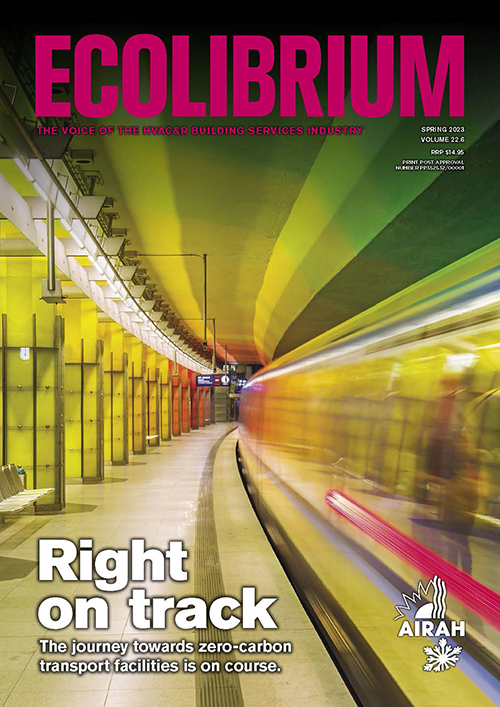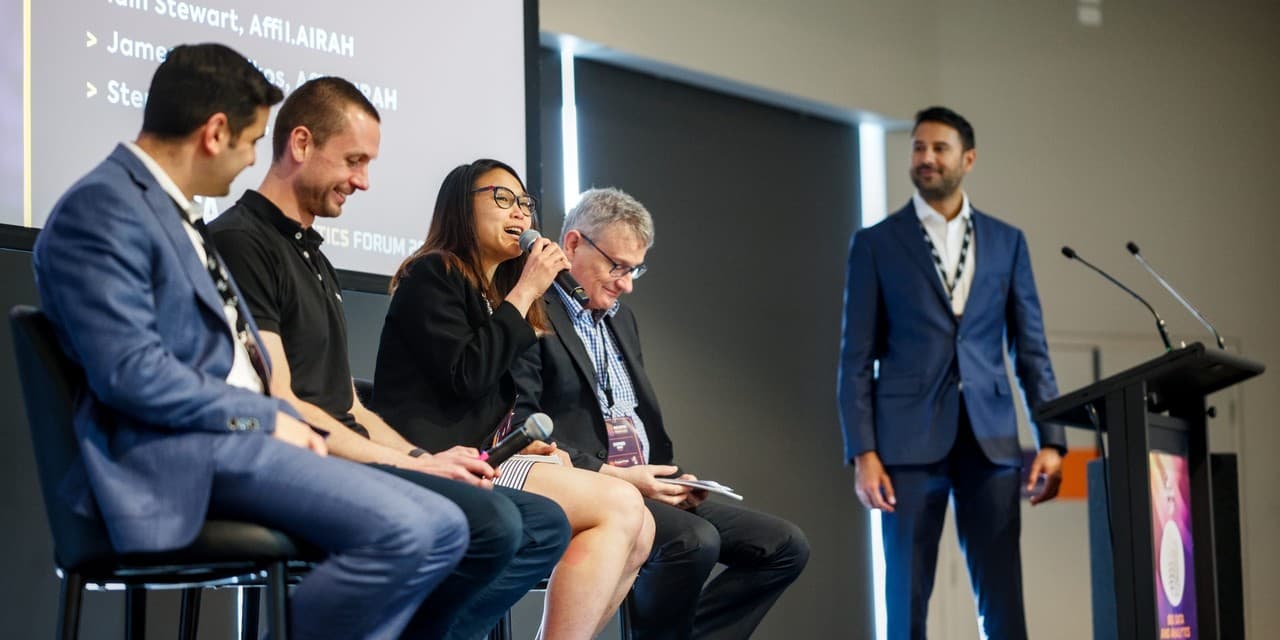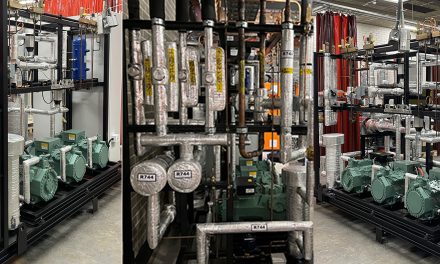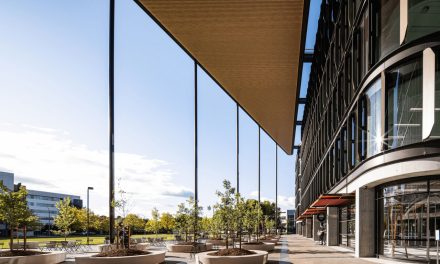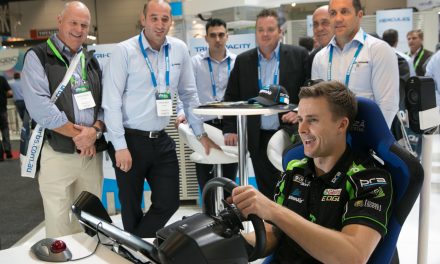What role does data play in the electrification of buildings? With a focus on machine learning, artificial intelligence and the interaction with the electricity grid, a panel at AIRAH’s recent Big Data and Analytics Forum explored this fascinating topic. Moderated by Grosvenor Engineering Group’s Roshan Gill, M.AIRAH, the panel included Grace Foo, M.AIRAH, from DeltaQ; Iain Stewart, Affil.AIRAH, from Exergenics; James Giannikos, Affil.AIRAH from ISPT; and Stephen White, L.AIRAH, from CSIRO.
Roshan Gill: Let’s explore how ML and AI are augmenting the way the grid is operating. So how is value derived from ML in this case?
Iain Stewart: Most people in this room would know that if you fit in a whole bunch of BMS data into a neural network you’re probably not going to get anything interesting. But using the simplest possible regression model or natural language processing can help you solve a specific-use case across a pipeline that gets you to whatever you’re trying to do at the end of the day. If this is to build a model of a system, then you might use 15 different algorithms that are all quite simple when they’re used in isolation. But then actually stitching those together when you can build these simulations and start to get useful insights out of it – that’s the real benefit of machine learning, at least at the level that we’re at right now.
I’m not seeing a whole bunch there in terms of, “The AI is going to solve everything, and let the black box in the cloud go and handle it”. That doesn’t seem to be much more than marketing fluff.
RG: James, do you see applications that describing themselves as AI that are effective within the portfolio?
James Giannikos: It’s becoming something that will be pervasive, and more and more systems will leverage AI for some reason or another. We’ve all had colleagues in our office that have jumped on Chat GPT and asked some life-meaning questions to see what that generates out.
The extension to that is to ask could you apply a similar lens across your organisational data or your sustainability data and see how it can start to give you insights around you as an organisation – any trends, any patterns – ask it a question and see what the answer is.
But that’s all – not to say fluff and marketing spin – but there is in the industry a lot of people saying, “Yeah, yeah, yeah – this is what we can do”. But it’s in its infancy in terms of its maturity level.
What they can do is probably a version of ML and AI. A lot of that stuff needs clean data sets that we can feed it that it can then draw insights from. It’d be a very dangerous thing just to say, “Here’s a huge data set and let’s commercialise that and see how we go”.
Absolutely it plays a role, it’s got a place. We’re trying to establish what that means, how we leverage it. How do we bring value?
Value in itself is an interesting question. When you talk around a business case and value, it’s not always around the financial value. There’s always operational uplift. We talk through this whole grid demand-response electrification … the one thing that hasn’t been said is that from our perspective, tenant comfort is non-negotiable. So yes, we want to electrify, yes, we want to do grid response, demand shift, peak demand management – absolutely.
But there is a window to that too, because at the end of the day, we know we have occupants in our buildings who we have to keep it safe, healthy, comfortable. That’s where we’re trying to find that sweet spot. Trying to leverage something like AI to help us do that heavy lifting around data would be something that we would definitely look into.
SW: So, I guess machine learning – that is, learning from historical data, is always going to be subject to all the data quality issues that we’ve talked about before. If you had garbage in at the beginning, any machine learning you do on the top of that is going to be garbage as well. So, there are certainly risks there.
The other sort of subset of machine learning is reinforcement learning, which is where you put out a kind of a cost penalty function and then you just let the algorithms “explore”, if you like. So, it doesn’t rely on the historic data. And that can be a good thing. Probably you want to put some very firm constraints on where the algorithms can explore.
But the good thing is then you’re not constrained by the bounded rationality that we have in our industry around things “have to be this” kind of thing. Yes, put your constraints around where you can explore, but just let it explore and see what optimisation comes out of it. Perhaps we’ll go down that track to some extent in the years to come.
JG: To get your mind around optimising for grid intensity doesn’t actually align to optimising for energy savings. So it’s sort of like, “Well then hang on, where do we find that middle line of saying which one do we want to work?” Yes, we want to be optimising to grid intensities but no, we want to also retain our energy effectiveness. We can’t let our NABERS ratings drop.
The price of carbon might influence that, because then all of a sudden, it’s more of a financial gain to be leaning towards grid intensity as opposed to energy optimisation. But when a lot of our contracts sit within the energy optimisation space, we need to rethink the holistic issue at hand. It’s not as clear-cut as we approach it, but you’ve got to start somewhere.
We’ve started doing some rough modelling to see where that line is, and interestingly enough, there were slim margins in time where you could both get a grid intensity gain and an energy saving.
RG: So given the fact it’s quite complex to be able to effect some sort of demand response within the building – for example, different bands shutting things on and off – and balance that against thermal comfort and against the actual time of the day when it might be financially viable for you to participate in the market, does it mean that we have to have ML or AI before we can actually get to that point and have buildings participate?
GF: I don’t necessarily think so. As an industry, as James pointed out, we are in our infancy. Honestly, we’re still talking about the same problems that we’ve known were problems five years ago. So, let’s get the basics right.
We need a standard so we can stop talking about tagging and oncology, and just move on to the next big-picture item. But when you’re talking about the term “grid-interactive buildings” in order for buildings to no longer be just users of electricity by active participants, we need a two-way feed in data. And unfortunately, that data may not be available.
Do you need machine learning or fancy AI for that? No, we just need the data, damn it. Just give us the data and we can do dumb modelling at that point to at least tell us how a building should respond and if there is even value in responding at that point.
Of course, the next tier is actually then optimisation scenarios modelling of, “What do I actually want to optimise for?”
Two years ago, I was in the in the UK for a conference and there was someone who presented them modelling 24/7 carbon emissions. They were trying to model the best time for their buildings to turn on certain systems based on carbon emissions as well as the cost of operation. I don’t really see a lot of that happening here, but perhaps the conversation is starting to shift, so that’s useful.
But they didn’t have ML or AI. They were doing scenario modelling based off historical data, so I think that’s the next step. Once you’ve got our data right, tagging right, we’ve got two-way feeds. Then we can do static historical modelling to help inform our choices.
Then let’s talk about AI and we can start talking about predictive – what’s happening in the market, what’s happening with outside air temperature? What’s happening actually in my in my building? Am I still going to meet conditions?
But we’re not there yet, so it’s a nice road map of where we want to head towards, to actually get to net zero emissions. But I would say to focus on the basics, so we don’t end up with rubbish in/rubbish out. I mean, it’s useless talking about fancy stuff.
SW: Just to clarify, I don’t think that we need machine learning. What I’d like to feel confident about though, is that I’ve got good data monitoring around the building so that I’m feeling confident that nothing is going out of whack that I want to monitor, obviously comfort being the main one. And generally speaking, I kind of see there’s plenty of opportunity for improving comfort, and if the flexibility pays for the extra sensors and stuff around the place to understand comfort, because I don’t feel like we have a good control over our comfort at the best of times in normal buildings. So once we get more granular with our measurement, we can both manage risk and also improve comfort, would be my hope.
JG: If I could just sort of give my lay of that – while I agree even though we did not need these technologies, that’s the way we’re trending. We’re installing AC units where we’re connecting everything together. A BMS has enough data as it is, to the point that we can’t really get a proper handle on it, as we keep connecting [things such as] lighting control, access control, vertical transport. All of a sudden, we want to also connect in CCTV.
The heavy lifting needs to get done by someone. We can’t expect that to be purely a person, but I can’t also expect it to be wholeheartedly a machine either. So, we’ve got to sit in that middle part –It’s got to have the oversight, it’s got to have someone to be that Master Integrator, or understand the services. Otherwise, it’ll just be the “wild, wild west” times six or seven.
GF: Are we also asking a question of which building types we’re tackling? Some buildings would be really mature in that journey in which case they really should be investing in it. And there are bottom-of-the-rank buildings, which barely have a functioning BMS. I would not be talking about anything fancy with for them. It really is about getting the basics right, get your energy data right.
But for those on the top tier, they’re the ones that can prove they can be the early adopters that create case studies that inspire the rest of industry. But ultimately for us to have a commercial product, you need a large enough market to cater for your investment in it.
Thinking carefully about which market segment you’re really targeting will also define how much you would want to go towards AI.
IS: Echoing Grace’s point, the simplest thing that you possibly can do is probably the right thing to do, and then build over time.
To the point of the stranded assets, there are going to be AI/ML solutions that are coming out in two, three, four, five years. And the more high-quality training data that you have, with the energy markets are only going to increase in volatility. The wholesale markets are already cooked in Queensland where you’ve got long periods of negative pricing throughout the day, there’s going to be economic incentive. There is economic incentive now if you can access it – it doesn’t quite stack up yet, but that’s only going to increase as there’s more volatility in generations.
It’s going to be hard with a risk-averse industry to justify that business case and putting it in now. But then that’s one of many potential applications that can be on there. It’s about finding a way to justify bringing in high data to an independent data lake that you can then leverage at some time in the future. That’s the best way to sort of avoid the stranded assets and be ready.
I don’t like the word, but do the future-proofing and get that part right. But if you can work out a business case, that’d be a good way to go.
RG: Can we get from net zero to actual zero?
SW: I’d love to talk to that. I don’t know what your level of scepticism is around the room of doing this kind of stuff. Demand response has been around a while – did it ever really take off? And so, is anything different? That’s something that I would like to close on. All credit to AIRAH for putting this on the table. It is a new topic.
Here’s a thought experiment: We are electrifying. Why are we electrifying? Because the grid is going to go zero carbon. What does that mean? There’s going to be great swags of solar PV. South Australia last week was running at 97 per cent rooftop PV for the entire state, and the additional solar farms and wind were exporting another 20 per cent to Victoria.
The future of electrification is that renewables are going to be going off in the middle of the day and let’s now think what does that mean for net zero for buildings? Net zero for buildings probably means we’ve packed a whole lot of PV on our roof and we want to export our solar and get carbon credit for that – what does that mean? It’s going to be pushing into a grid that’s already spilling solar energy – throwing it away because no one knows what to do with it. Why would you give solar credit for that stuff in the middle of the day?
So, I asked the CSIRO team to do some 24/7 carbon tracking. Give me zero carbon credit for the solar, and then what is my net zero building actually doing?
And when you do that, it’s still about a 50 per cent of current emissions are being emitted because you’ve got no value for that export credit because the grid can’t accept it anymore.
So, this is a new world that we are going into, and it’s about shifting of demand as being as important as the renewables itself. That’s just a bit of perspective of why it’s such an important thing and we’ve got a role to play.
GF: So as an industry will things change? Yes it will change, and as Stephen pointed out it’s going to be about flexible demand and the reason for that is because we have to transition away from a centralised supply system to something that’s decentralised.
To facilitate that you need the data, and if you’re thinking about where you prioritise that data so you’re prepared for that change that’s going to happen rapidly because of a net zero targets, you start thinking about what’s most important. Do I know at the point when there is lots of clean supply from the grid what my building is doing at that point? And how is my building going to react when it’s at its peak when there is going to be high carbon emissions from a generation perspective?
Now for most commercial office buildings, that might not be an issue. So, when you think about where you collect your data and optimise for flexible demand maybe that’s not where the commercial value is. But when you’re working in critical buildings or 24/7 buildings, the value in the data that you’re collecting in order to interact actively might change.
The GBCA has released their new grid interactive paper and it’s startling – 50 per cent of electricity generation is consumed by buildings but in peak period is going to be 77 per cent of system capacity. So thinking about the building types that would be affected would be really important in how your building will react and the data you need to collect in order to respond to it.
IS: I’m going to agree with both the points so far. It will be a massive part of the future and how buildings and the grid interact and behind-the-meter participation. I have a pessimistic view, though – I don’t think anything will change in the short term until there’s a change in reporting and moving away from annualised state-based-grid-emissions intensity reporting through to scope two.
There is very little impetus there for anyone to change and do the load shifting and take that risk unless there’s actually a material benefit. So, if that can come through to NABERS or the state reporting or federal reporting of those emissions, that will help.
And then we’ll see how quickly the energy markets move to incentivise demand response at smaller variable loads. That could be another big win, but I don’t think too much will change until that’s really happening.
JG: From my perspective it’s old strategy of you crawl, walk, run. So you’ve got to approach in that manner. At a micro level you can do small things quite simply regardless of the asset type.
It’s about approaching it from the lens of that’s the low-hanging fruit I can do that doesn’t involve a lot of investment in terms of additional infrastructure equipment other than tidying up your own backyard.
But at the macro level it’s got to be about the whole of the building, so we’re not just focusing on certain elements. It’s from an operations lens house, how is this going to impact our asset? From a tenant experience lens, how are they impacted by this? They are part of this problem, so they are part of the solution.
We’re trying to engage our tenants on this journey as well, because they need to acknowledge that yes, we are here to provide comfort, amenity and of all the above but they’re also part of journey on our scope three missions. If we go down that pathway then we need to know how their ecological footprint is impacting us.
It’s one of those things where you can bite it off in small chunks. It’s like eating an elephant – one bite at a time. You don’t have to come up with the whole answer at once but you’ve got to be in the frame of mind and be able to pull yourself up when you want to go macro but then also go back down at that micro level and get that business case right.
